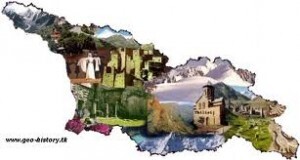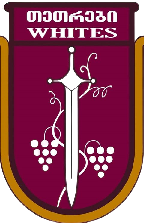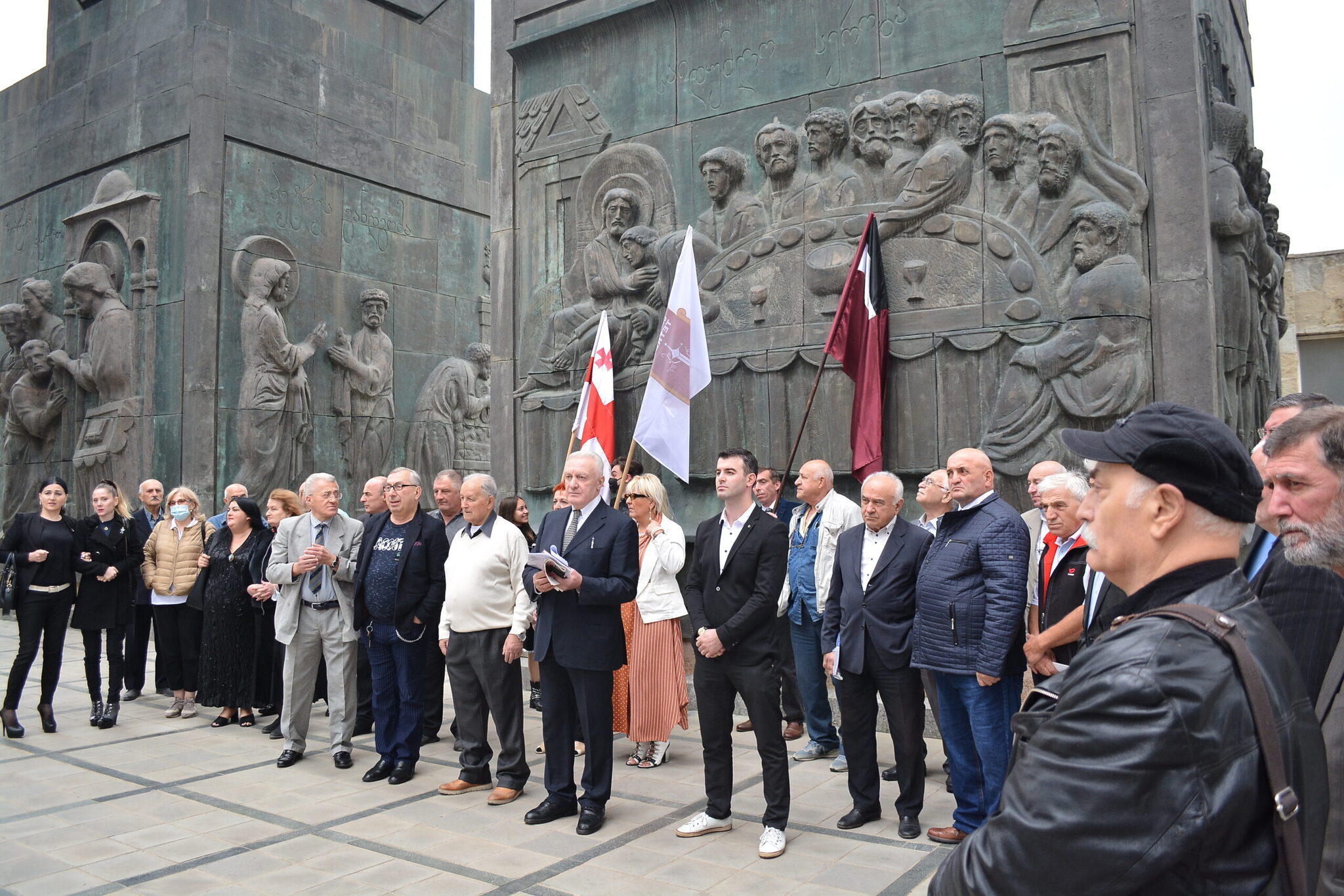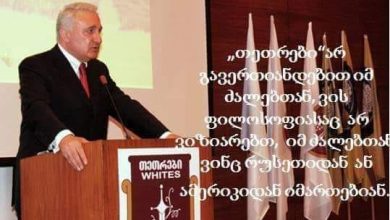THE OSSETIANS UNDER THE GEORGIAN BANNER
Professor, Dr. NIKO JAVAKHISHVILI
(The second half of XVIII century)
 The history of Georgian-Ossetian relations traces back to the ancient times.
The history of Georgian-Ossetian relations traces back to the ancient times.
In the 4th-3rd centuries AD, the first kings of Kartli, Parnavaz and his son, Saurmag, reasonably carried out a prudent Caucasian policy that gave a positive result for the country.
Leonti Mroveli’s work The Life of the Kings of Georgia evidences that Parnavaz, waging war with Azon, who wielded power over Kartli, successfully availed himself of the support of Sarmatians of Iranian stock (relatives of the Ossetians). Victorious Parnavaz gave the Sarmatian king his sister for marriage as a token of gratitude.
In the 2nd century AD, almost the entire spectrum of the Caucasian tribes was presented in Georgian army. At that time, the Sarmatians, along with other North Caucasian nations took an active part in coalition campaigns carried out by the Georgians against the powerful Armenian state.
The present essay deals with a survey of one of the important sections of the centuries-old history of Georgian-Ossetian relationship – the second half of the 18th century.
The Georgian kings, under the grave international and domestic conditions existing in that period of history, had a reliable support in the person of the North Caucasian mountaineers.
The military alliance of the Georgian and Ossetian peoples became especially intensive when Teimuraz II and his son, Erekle II, ascended the thrones of Kartli and Kakheti (1744).
The two kings had high prestige with the North Caucasian peoples. That was natural, as the mountaineers regarded the Georgian kings as their kinsmen. Noteworthy is that Queen Rusudan (wife of Vak¬htang VI), mother of Teimuraz’s wife, Queen Tamar, was a daughter of the Great Prince of Kabarda. His family carried great authori¬ty not only in Kabarda but also throughout the North Caucasus. Moreover, not only the Adigian peoples – Circassians and Kabardians but also their neighbour Ossetians, Karachai-Balkarians and part of the Vainakh peoples – Ingush were subordinate to the Great Prince of Kabarda.
Thanks to this connection most of the North Caucasian peoples faithfully served Erekle II.
It should be taken into consideration that all the peoples living in the Northern Caucasus in the given period were rallied under the banner of Georgia with the exception of the part of the Daghestani mountaineers, who, as usual, made marauding assaults on the Georgian population. Furthermore, sometimes they were even found among the traditional enemies (Ottoman Turks and Persians) of Georgia.
From the early 60s of the 18th century, Erekle II earned a reputation of the powerful sovereign. Following the brilliant victories in bloody struggles, he managed to subjugate the majority of khanates existing in the territory of the Southern Caucasus.
In the words of academician Niko Berdzenishvili, “Erekle always skillfully assessed the armed forces of the adversarial khans and took appropriate measures in due time”.
Teimuraz II and Erekle II were fated to reign in difficult conditions of incessant struggles. To tell the truth, that kind of condition was characteristic to the entire historical past of Georgia, but the situation was extremely aggravated in the mentioned period.
In June of 1747, in the environs of Khorasan, Nadir-Shah fell a victim to the betrayal. That was followed by the instability in Persia and its subordinate khanates, which resulted in a bloody struggle for the hegemony in the Eastern Transcaucasia. In the course of this struggle, the priority of Kartli and Kakheti was evident.
In the mentioned period, Erekle II, nicknamed “Patara Kakhi”, was at the age of 28, but according to Niko Berdzenishvili, “he was not only a brilliant military man but also an astute politician and a clever statesman”.
From the second half of the 18th century, 14 khanates existing in that period in Transcaucasia remained to be nominal subjects to Persia. Hence, the rulers of the khanates of Yerevan and Ganja appealed to the kings of Kartli and Kakheti for help. With the purpose of safety from external threat, they preferred to be under the protection of the Georgian kings.
Teimuraz and Erekle took advantage of the situation and in 1748-1750 gave decisive battles with the participation of the North Caucasian mountaineers for incorporation of the khanates.
The abolition of the practically autonomous Aragvi and Ksani dukedoms and their accedence to the kingdom of Kartli-Kakheti produced positive effect on the consolidation of the unity of Eastern Georgia with the Northern Caucasus.
In 1743-1744, Teimuraz II and Erekle II jointly carried out this significant action. After that, movements between Kartli-Kakheti and central North Caucasus became more intense, the more so as there no longer were artificial obstacles.
Papuna Orbeliani, a political figure and well-deserved historian of the 18th century, wrote in his work The History of the Georgians that “Georgians were anxious to wage war against the Persian army. They rallied the troops in Tbilisi, among them were the Georgians from Eastern and Western Georgia, the Circassians, the Ossetians and other Cau¬ca¬sians”.
The Ossetians, as well as other North Caucasian peoples (mainly the Circassians and Va¬i-nakhs) took an active part in military campaigns conducted by Teimuraz II and Erekle II. The Georgian kings generously presented their loyal allies with many presents multiplied with their share of jointly seized spoils of war.
In 1750, having defeated Fana-Khan of Shirvan, the coalition ar¬my of the Georgians and North-Caucasian peoples solemnly celebrated the glorious victory in Tbilisi.
According to Papuna Orbeliani, King Teimuraz II “disbanded the army of the North-Caucasian mountaineers, presented many gifts to the Circassian and Ossetian warriors and their commanders and sent them home”.
It is evident from the above-mentioned information that the North Caucasian mountaineers pa¬rticipated in military operations of the Georgian kings for certain recompense. The sources also claim that not only the North Caucasian Ossetians but also the Ossetians inhabiting in the mo¬-untainous region of Inner Kartli (Shida Kartli) participated in military actions under the Ge¬or¬gi¬an banner.
At the same time, it is markworthy that the Georgian kings rewarded the North-Caucasian Ossetians only. As for the Ossetians living in Georgia, they, like the local, georgian mountaineers: Mtiulis, Mokheves, Tushis, Pshavis and Khevsuris, served the king as his people, hence, in case of victory they got the spoils of war only.
In 1751, the ruler of Tabriz, Azat-Khan, who attempted to extend his influence over entire Persia, gathered a strong force of the Afghan warriors and led a campaign against the khanate of Yerevan, a tributary to Kartli and Kakheti.
The khan of Yerevan appealed to his suzerain kings – Teimuraz and Erekle for assistance. The Georgian sovereigns immediately sent their representatives to “Circassia, Ossetia and other countries of the North Caucasus to rally the troops. The Georgians also began to get ready for the war”.
The arrival of the Ossetian troops is described in a historical source: “The army of the Ossetians came to the city from the North Caucasus. The king provided them with food supplies and sent them with escort to his son. They joined King Erekle’s forces in Bambaki”.
Erekle II had prepared for the arrival of the Ossetian warriors beforehand. An extract from the king’s letter is illustrative of his brilliant managerial abilities.
Erekle II wrote to Prince Revaz Amilakhvari: “I received your letter about the Ossetians. You will be given the food supplies for the army: the bread – from the king’s granary, the vodka – from the town of Gori and the livestock – from Prince Giorgi Eristav Send someone to them and take the supplies. All must be kept at Ioseb’s – the writer’s brother, tell him to give out the supplies little by little. There are fifteen cows and fifteen sheep there. The vodka will be ready. Six pitchers a day If seven – take it on credit The Ossetians must be supplied sufficiently till we meet and, may the Lord help us, we will do our best The cost of foodstuffs should be written down in the receipts. Our officials will repay later on… Be careful of unforeseen expenses”.
The battle, which took place near Qirabulah, in the vicinity of Yerevan, ended in a complete rout of Azat-Khan’s army, 18 thousand in number. Some sources claim that Georgian forces nu-m¬bered even less than one fifth of the enemy’s numerous troops.
This victory significantly heightened the prestige of Georgian kings.
The subjection of the most part of Transcaucasian khanates to the Kartli and Kakheti kingdoms caused redistribution of authorities in the region. This, in its turn, stirred up anger of the founder of Shaqi khanate and its first ruler, Haji-Chalab (Haji Cheleb Qurban-Oglu), and intensified the marauding raids of the Daghestani tribes on Kartli and Kakheti.
Formerly, Haji-Chalab recognized political superiority of the Kartli and Kakheti kingdoms and even allied himself with the Georgian kings in the campaign conducted for subjugation of Qarabag in 1749-1750.
Niko Berdzenishvili wrote: “Haji-Chalab allegedly was on friendly terms with the Georgian kings, but the strengthening of neighbouring Georgia gave him no rest. After the conquest of Chari-Belaqani and Kaki-Eniseli, the Georgians became immediate neighbours of Shaqi. And so, Haji-Chalab was secretly preparing for a decisive struggle”.
In January-February of 1751, Haji-Chalab took part in the campaign conducted by the Georgians to make the so-called “free communities” of Chari-Belaqani obey. There he betrayed the Georgians and, on 11 February, took the enemy’s side at a crucial moment of the battle waged on the bank of the River Agri-chai (present-day Azerbaijan). Haji-Chalab won the day and conquered the khanate of Kaki and Chari-Belaqani.
Thereafter, Haji-Chalab claimed for sovereignty on Transcaucasia and formed an anti-Georgian coalition, which, along with Shaqi, included the khanates of Avaria, Kuba, Karakaitagi and others.
In April of 1752, Haji-Chalab defeated the Georgians for the second time in Ganja.
It was necessary to punish the impudent liegeman Haji-Chalab properly to retain the international prestige of the Kartli and Kakheti kingdoms. With that end in view, Erekle II and Teimurz II began to prepare for a decisive battle at once. They engaged an army comprised of the North Caucasian (Ossetians, Circassians, Vainakhs and Daghestanis) warriors again and sent Zurab Ze¬d¬¬ge¬nidze to the North Caucasus to accompany the troops on the way to Georgia.
“Erekle put his heart and soul” into this drastic undertaking aimed at the destruction of the dangerous enemy.
Prince Bagrat (1776-1841) writes in his work A New Story: “Haji-Chalab of Shaqi, who seized Shirvan, Nukhi and Shemakha. He rallied the troops of Shaqi, Shirvan, Ganja, Karabah and Daghestan and moved on Kartli. He raided into Georgia and occupied its territory from Shamshadilo up to Algeti”.
By order of Teimuraz II and Erekle II, gold and silver wares were taken out of the royal treasury to mint coins for hiring the foreign forces. After that, Erekle determined to go to the North Caucasus to arrange about the army.
In April of 1752, Erekle II arrived in Khevi to meet the Circassian feudal lords. According to P. Orbeliani, “the king went to Circassia. He stayed in Khevi and sent his sons to Circassia. The Ossetians were the first to come. Later the Circassian commanders came to settle the affair of the army. Having received the payment, they left and gathered a force. The Circassian army, five hundred-strong, was led by the uncle of Erekle’s mother, a Circassian feudal lord.
On 19 June of the same year, Erekle II wrote to Catholicos Anton I: “In two or three days, with God’s help, we are leaving for Khevi and perhaps we will have to go to Circassia too”.
In July, Erekle II left for the North Caucasus again to lead the complementary force to Georgia.
Prince David (1767-1819) writes about the arrival of the North Caucasian troops in his work A New History: “King Teimuraz II sent his son Erekle to Stepantsminda to rally the Circassian mounted troops. And then the cavalry appeared”.
In the words of prince Bagrat, “King Teimuraz II sent his son to the North Caucasus Erekle gathered the Ossetians and Circassians and led them to Kartli”.
Prince Teimuraz (1782-1846), younger brother of princes David and Bagrat, also describes the arrival of the North-Caucasians in his work A New History.
The Georgian historian of the second half of the 18th century, Oman Kherkheulidze, confirms the splendid triumph of the Georgians fighting against the enemy together with the North Caucasian warriors.
The North Caucasian forces joined the army of Kartli-Kakheti, known for its military efficiency. The troops encamped in the environs of the village of Digomi, near Tbilisi.
According to some sources, the Northern Caucasians numbered 4 thousand.
The coalition army of the Georgians and Northern Caucasians (Ossetians and Circassians) began to prepare for a decisive battle. The nu¬merous enemy force led by Haji-Chalab’s son, Aga-Qishi (Aga-Oghlain – according to other sources) tried to avoid a man-to-man fighting. Aga-Qi¬shi was supported with his allies – the Daghestanis and the khan of Ganja with his armed forces.
Aga-Qishi offered the Georgian kings to conclude an armistice, but the suggestion was turned down by Teimuraz and Erekle, as “it would not be right for them to refuse a combat”.
At the end of August in 1752, the Georgian army left Tbilisi. That was sufficient for the frightened enemy to make a hasty retreat and move from Baidar to Kazakh.
According to prince Teimuraz, “when the Georgian kings left Tbilisi to join the battle, Aga-Qishi retreated”.
A certain part of the retreated army was crushed by the advanced detachment of the North Caucasian troops. The enemy tried to strengthen the position near Ganja. The coalition army acted under command of Teimuraz II and Erekle II. They disposed the infantry on the positions abandoned by the enemy forces and, accompanied with the cavalry, chased after the retreating rival.
Erekle II led the advanced troops formed of the young Georgian princes together with the Ossetians and Circassians and a Georgian force under command of the governor of Qiziki (part of Kakheti) – Ta¬maz Andronikashvili.
Papuna Orbeliani in his work vividly describes the bloody battle, which took place near Tulqitapa on September 1: “King Erekle, mounted on the best horse, pursued the enemies like a falcon, and caught up with them at the border of Kazakh and Shamshadilo.
When the Georgian troops approached, the enemy army stopped and tried to wage a fight. At first, they even managed to make the Ossetians run away. It angered King Erekle to learn that. He took the lead of the army and joined the battle like a lion. Having seen that, the warriors could not but go into action”.
The above-cited extract is illustrative to the importance of a commander’s bravery and courage for the fate of a battle. It serves as an example to the warriors.
According to Prince Teimuraz, the battle was waged in Shamshadilo, “in the location called Tu¬lqi-tapa. The defeated enemy retreated. The Georgians started in pursuit of them and slaugh¬te-red them up to Shamqori”.
Following the defeat of the enemy army, Teimuraz and Erekle lavished gifts to the loyal Muslim feudal lords; some of them even got back their lost domains. Their former vassals, who had taken Haji-Chalab’s side, suffered severe punishment for treachery.
The glorious triumph was properly celebrated in Tbilisi. Catholicos-Patriarch Anton I held a thanksgiving service at the Sioni Cathedral. “They fired cannons; the city was engulfed by indescribable joy”. 35
According to N.Berdzenishvili, “This victory yielded a great result for Georgia. Shortly after that, the unity of the hostile khanates broke down. The rulers of the khanates of Yerevan and Ganja as well as other khans led by the khan of Shaqi against Georgia chose the path of friendship and obedience to Teinuraz and Erekle again”. 36
Leaving Tbilisi, the commanders of the North Caucasian troops promised the Georgian kings, “As soon as we receive your command, we will be at your service; we will give up our lives for you”. 37
In 1754, the ruler of Avaria – Nursal-Beg, tried to organize a new military coalition against the kingdoms of Kartli and Kakheti. In the case of Nursal-Beg’s victory, as it had been agreed, Aga-Qishi, the son of the Khan of Shaqi, Fana-Khan of Shirvani, Khan of Ganja, Sultan of Kaki and the Daghestan – Surkhav with their troops and a force of Chari-Belaqani were ready to join the coalition.
Papuna Orbeliani wrote: “They all participated in the plot. If the ruler of Avaria had inflicted a defeat on the Georgian kings, they would have crushed Georgia”.38
In August of the same year, after razing to the ground several inhabited localities of Kartli-Kakheti (Ruispiri, Akhmeta, Dusheti and others), a numerous army led by Nursal-Beg besieged the Mchadijvari Fortress.
In the battle waged on 16 August, the Georgians inflicted a crushing defeat on the impudent enemy and killed the commander’s uncle and cousin. As cited from a reliable source, “the Georgians were fighting so bravely that people praised them to the skies. Although the Georgians are known for their courage, on that day they scored a splendid victory”.
The forces engaged in the North Caucasus also appeared before the victorious king. In the words of a historian, “the troops of the Circassians, Kalmyks, Chechens and Ingush, Nogays and Ossetians arrived in Ananuri. These armies had their commanders. They practiced different religions, many of them were the heathen, others were Muslims; some of them were good-looking, others were of disheveled appearance, bald-headed and snub-nosed, however, all of them were good riders and archers. Prince Jimsher led them to Georgia. They encamped in Didube, in the outskirts of Tbilisi, and were provided with sufficient food supplies”.
The arrival of the North Caucasian force in the village of Tabakhmela caused alarm of the enemies of Georgia. According to historical sources, “Everywhere was heard a rumour that Georgian king had rallied a great force of foreigners”. At the same time, it became known that the ruler of Avaria had suffered a defeat and this bewildered the enemy”. 39
Later on, the North Caucasian warriors set a camp on the Digomi valley. It happened that the enemy did not dare mount an attack, and the grateful king generously rewarded the mountaineers and dismissed the army.
Nursal-Beg, infuriated with the defeat, organized a new coalition against Kartli-Kakheti. The shamkhal of Targhu, Surkhai-Khan, Haji-Chalab’s son Aga-Qishi, the sultan of Kaki, the khan of Ganja with their armies and the Charians were united in the coalition.
In 1755, Nursal-Beg attacked Georgia for the second time. He led a 20 thousand strong army of Daghestan and Chari-Belaqani to Kakheti.
Erekle II sent Prince Ramaz Andronikashvili to the North Caucasus to rally a force. A not numerous army of the North Caucasians arrived under command of a Kabardian feudal lord, the future father-in-law of prince Giorgi, Erekle’s son. 40
The enemy troops surrounded the Kvareli fortress, but failed to seize it. The fortress was well fortified and the siege lasted for a long time. Erekle II attempted to break up the coalition army. With that end in view, he ordered the cavalry from Qiziki to assault the troops of Chari-Belaqani. As a result, the Lezghins were forced to raise the siege and return home. This fact stirred up discord among the allies.
The action of the Chari-Belaqani army served as an example to the others. The sultan of Kaki, Surkhav and Haji-Chalab with their tro¬ops withdrew from the area and left the ruler of Avaria alone. Thus, Erekle II succeeded in breaking up the powerful enemy coalition.
It is evident that the North Caucasians won fame in this military campaign too, as, on returning to Tbilisi, the Georgian kings rewa¬r¬ded them, along with the distinguished warriors of the Kartli-Kakheti army. In the words of a historian, “the Ossetian and Circassian warriors were given lavish gifts”. 41
The military alliance of the Georgian and North Caucasian peoples was successfully maintained for a long time.
Not infrequently, the Ossetian military allies of the Georgian kings earned praise for their bra¬very. The Bagrationis had paid them salaries since the olden times, therefore, they, rallied ro-und the banner of Georgia, faithfully served the Georgian kings. Their charters were periodically renewed, hence, they would appear in Georgia at the very first call of the Georgian kings.
The Georgian historical sources provide an abundance of information about the Ossetian troops and it is noteworthy that the Oss¬e¬ti¬ans of the North Caucasus only were meant. We have already menti¬o¬ned that the Ossetes living in Georgia served in Georgian army as equals with the Georgian mountaineers.
The charters given out by the Georgian kings were mainly intended for the Ossetians of Tagauri community. Since the northern section of the road passing through the Daryali gorge was under their control, the Georgian kings regarded them with special favour. 42
It should be mentioned that not only the Georgians but also the local Ossetians were alarmed with the incessant marauding assaults of the Daghestanis. Hence, the Ossetians struggled against the enemy with the purpose of their personal security as well.
In 1759, a Daghestan army 8.000 strong led by Chonchol-Musa and Kokhta Beladi intruded into the territory of Kartli-Kakheti. The enemy forces divided in two. Chonchol-Musa invaded Samachablo, occupied the village of Achabeti and led away into captivity many Georgians. Thereafter, the enemy “launched an assault on the Ossetians of Samachablo, inhabiting in the valley of the River Liakhvi and approached the village of Avnevi”. 43
40 Ibid., 228.
41 Ibid., 233.
42 Giorgi Togoshvili, saqarTvelo-oseTis urTierToba XV-XVIII ss. , p. 142.
43 Oman Kherkheulidze, mefoba irakli meorisa, teqsti gamo¬sa¬¬¬¬cemad moamzada, gamokvleva, le¬q¬¬sikoni da sa¬Zi¬e¬be¬li dau¬¬¬r¬¬To lela miqiaSvilma, (The Reign of Erekle II, The text has been prepared for edition, complemented with the comments, glossary and indices by Lela Mikiashvili), (Tbilisi, 1989), 58.
The Georgians defeated the enemy once again.
Late in the summer of 1769, the Russian troops under the leadership of General Totleben marched into the territory of Georgia. At the request of Empress Catherine II, Erekle II joined the anti-Ottoman coalition.
The Ossetians took an active part in military actions carried out against the Turks.
The Ossetians formed a part of Georgian troops that waged a battle near Aspindza on 20 April 1770. King Erekle II even rewarded some brave Ossetian warriors with domains.
The following is an extract from the book of reward about granting a domain to the Ossetian Dokhchiqo Khetaguri, which was renewed by Erekle II in 1786: “Your son Bolatiqo was with us in Aspindza when we defeated the Daghestanis. He fought bravely and fell in action; he died the death of a hero”.44
The Ossetian cavalrymen also participated in the military operation carried out in Khertvisi on 25-26 October 1771. They acted under command of Akhmet Dudarov.
On 8 November 1773, Captain of the Imperial Army Lvov informed Count Panin that Erekle II and King of Imereti Solomon I had rallied 5-5 thousand Georgian warriors and about one thousand Ossetian and Ingush.
In August of 1779, when Erekle invaded Yerevan, among his warri¬ors were the Ossetians under command of Beslan Shanashvili, the aldar of Tagauri.
In 1785, the ruler of Avaria Omar-Khan raided into the territory of Kartli-Kakheti.
Erekle II prepared for a combat. According to the data of 20 September, there were 400 Ossetian and Ingush cavalrymen among his warriors.
The Ossetian mounted troops took part in the struggle waged for enthronement of Erekle’s gra¬ndson prince David, the son of Archil, (later known as Solomon II) in Imereti, which ended in a victory. 45
In January of 1798, Erekle II died at the age of 77.
In the words of Niko Berdzenishvili, Erekle II “was a great statesman and brilliant commander, a progressive leader, who devoted himself to his country. In spite of his old age, his death was an irreplaceable loss for the disturbed country”. 46
The funeral of the illustrious Georgian king at the Svetiskhoveli Cathedral was the manifestation of overwhelming grief of the Georgian people.
Vice-Chancellor of Kartli-Kakheti Solomon Lionidze dedicated an excellent farewell speech to his adorable king. Among other things, it is mentioned in his speech under the title” Mourning over the King of Georgia”: “When Erekle’s powerful flag flutters, the Daghestanis appear before the king, the Ossetians and Circassians willingly shed their blood for him”. 47
In 1800, King of Kartli-Kakheti Giorgi XII renewed the charter for Beslan Shanashvili, which reads: “You, Beaslan Shanashvili, had a salary from our father, the blessed king, and you lost the charter in the battle near Yerevan. Now we grant you brocade that is worth of forty marchili (a monetary unit in old Georgia) a year. When you come to us, the officials of the royal court will pay you completely. And you have to serve us as faithfully as before”. 48
It is noteworthy that the service of the Ossetian warriors is evidenced not only in the official documents issued by the Georgian kings, but also in the deeds given out by the king’s sons, princes. We can make mention of the charter given out to the Ossetians of Tbeti – the Tuauris, by prince Ioane on 30 September 1796, the order concerning the Ossetians of Zakhi and Trusso, issued by prince Vakhtang on 28 May 1798, etc. 49
44 The National Centre of Manuscripts of Georgia, Fund Ad, Reference № 1569.
45 Giorgi Togoshvili, saqarTvelo-oseTis urTierToba XV-XVIII ss. , p. 148-153.
46 Niko Berdzenishvili, saqarTvelos istoriis sakiTxebi, wi¬gni II, On the History of Georgia, Book II (Tbilisi, 1959), 240.
47 Solomon Lionidze, moTqmiT tirili saqarTvelos mefis Re¬¬r¬¬kules netarebis Rirsisa, XVIII saukunis avto¬gra¬fi¬u¬li xelnaweris mixedviT teqsti daadgina, narkvevi waumZ¬R¬¬¬vara da sa¬Zi¬e-ble¬bi daurTo nikoloz kandelakma, Tbilisi, 1957, p. 39.
48 The National Centre of Manuscripts of Georgia, Fund Hd, Reference № 13693.
49 Giorgi Togoshvili, saqarTvelo-oseTis urTierToba XV-XVIII ss. , p. 158-160.
Thus, the history of military alliance of the Georgian and Ossetian nations goes back to the ancient days, and the second half of the 18th century is its noteworthy constituent part. The Ossetians, as faithful warriors of the Georgian kings, were always regarded with favour by them.





